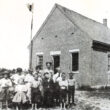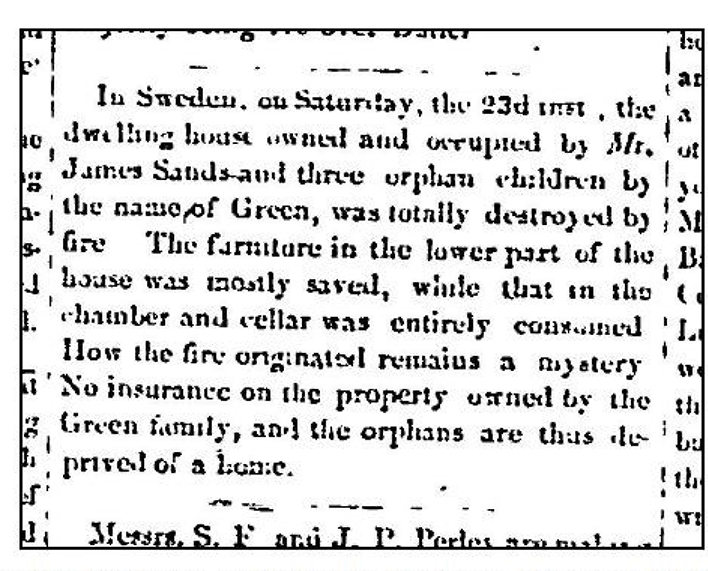
From the September 29, 1871 edition of the Bridgton News:
In Sweden, on Saturday, the 23d Sept, the dwelling house owned and occupied by Mr. James Sands and three orphan children by the name of Green, was totally destroyed by fire. The furniture in the lower part of the house was mostly saved, while that in the chamber and cellar was entirely consumed. How the fire originated remains a mystery. No insurance on the property owned by the Green [sic] family, and the orphans are thus deprived of a home.
So, who was James Sands? Was he married? Who were the orphaned children? Thanks to resources available through Ancestry.com and SHS files, we can learn more about the Sands and the orphans described in the Bridgton News.
See their story below.
James Sands of Maine
In 1860, James Sands (1806-1886), his wife Louisa (1805-1897), and daughter Charlotte (age 9) lived in Milo, Piscataquis County.
By 1870, James and Louisa have relocated to Sweden. Charlotte is not included in the household in the 1870 census: perhaps she died or married. From the 1870 census, we know that James Sands was a farmer in Sweden. He owned a total of 50 acres, of which 36 acres were improved. The value of his real property is $900. He has a single “milch” cow, two working oxen, three “other” cattle, one sheep, for a total of $240 in value. He grows spring wheat, indian corn, and buckwheat.
In the 1870 census, James and Louisa live with Frances (22), Eugene (18), Samuel (16), Lucy (13), orphaned children of William and Harriet Greene. The children’s maternal grandmother, Rebecca Bangs, also lives with them.
By 1880, James and Lucinda Sands were settled alone in Fairfield, Somerset County, Maine where James died in1886. Louisa died in Waterville in 1897.
The Green(e) Family
The orphans were children of William Henry Green (1815-1857) and his wife, Harriet Frances Bangs (1821-1860). William and Harriet (who died of consumption) are buried in Flint Cemetery. From various documents, we know that Harriet Bangs was not only a descendant of a Revolutionary War veteran, but also a Mayflower descendant.
William Henry’s father was William S. Greene, an early settler: coming to Sweden from Beverly, MA before 1813. From Pike: “He cleared the farm and built the buildings near the Bridgton town line, which was his home to the time of his death. The buildings were a little way from the main road, on the west. The entrance on which he lived has ever since borne the name of “Green’s Hill.” He died in 1867, and his wife died in 1861. The buildings were burned about 1870.”


